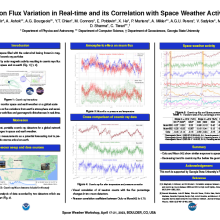Muon Flux Variation in Real-time and its Correlation with Space Weather Activity
Arfa
Mubashir
Georgia State University
Poster
We present a comparison of the measured cosmic ray (CR) muon fluxes from two identical detectors at different geolocations and their sensitivity to space weather events in real time. The first detector is installed at Mount Wilson Observatory, CA, USA (geomagnetic cutoff rigidity Rc~4.88 GV), and the second detector is running on the downtown campus of Georgia State University in Atlanta, GA, USA (Rc~3.65 GV). The variation of the detected muon fluxes is compared to the changes of the interplanetary solar wind parameters at L1 Lagrange point and geomagnetic indexes. We have also investigated the muon flux behavior during major interplanetary shock events and geomagnetic disturbances. To validate the interpretation of the measured muon signals, the muon fluxes are compared to the neutron flux measurement from the Oulu neutron monitor (NM) in northern Finland (Rc~0.8 GV). The results of this analysis show that the cosmic ray flux percentage changes from all stations are significantly correlated with each other and with solar wind parameters at L1, and the decreases of the muon fluxes can sometimes be observed several hours ahead of the onsets of the interplanetary shock arrivals at L1 and geomagnetic disturbances. Although this is yet an initial effort of building a global network of cosmic ray muon detectors for monitoring the space and earth weather in real time, the study provides evidence that muon network detection efficiency can be a diagnostic and forecasting tool for geomagnetic storms hours before they hit the Earth.

Poster PDF
Poster category
Geospace/Magnetosphere Research and Applications
Meeting homepage